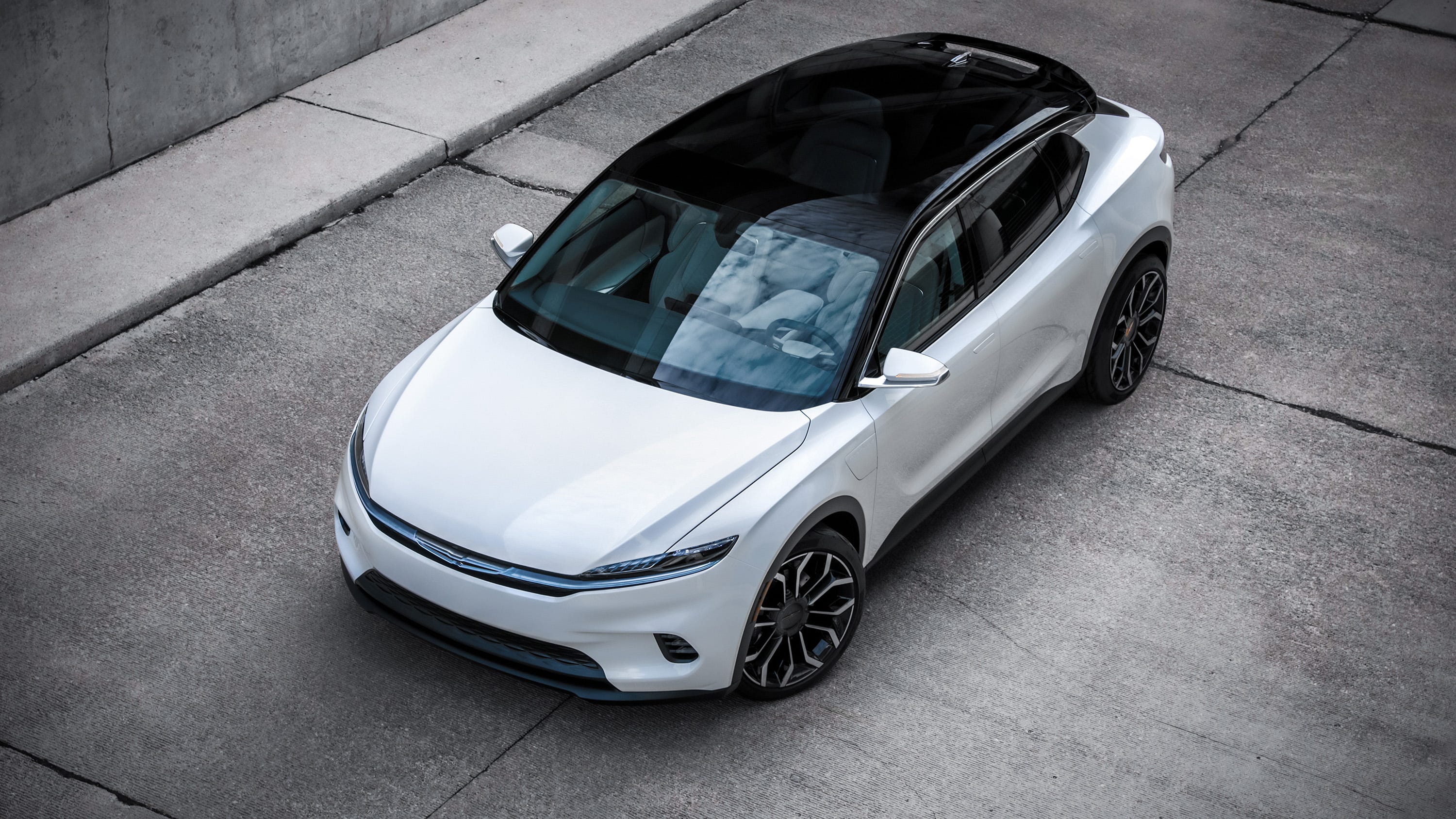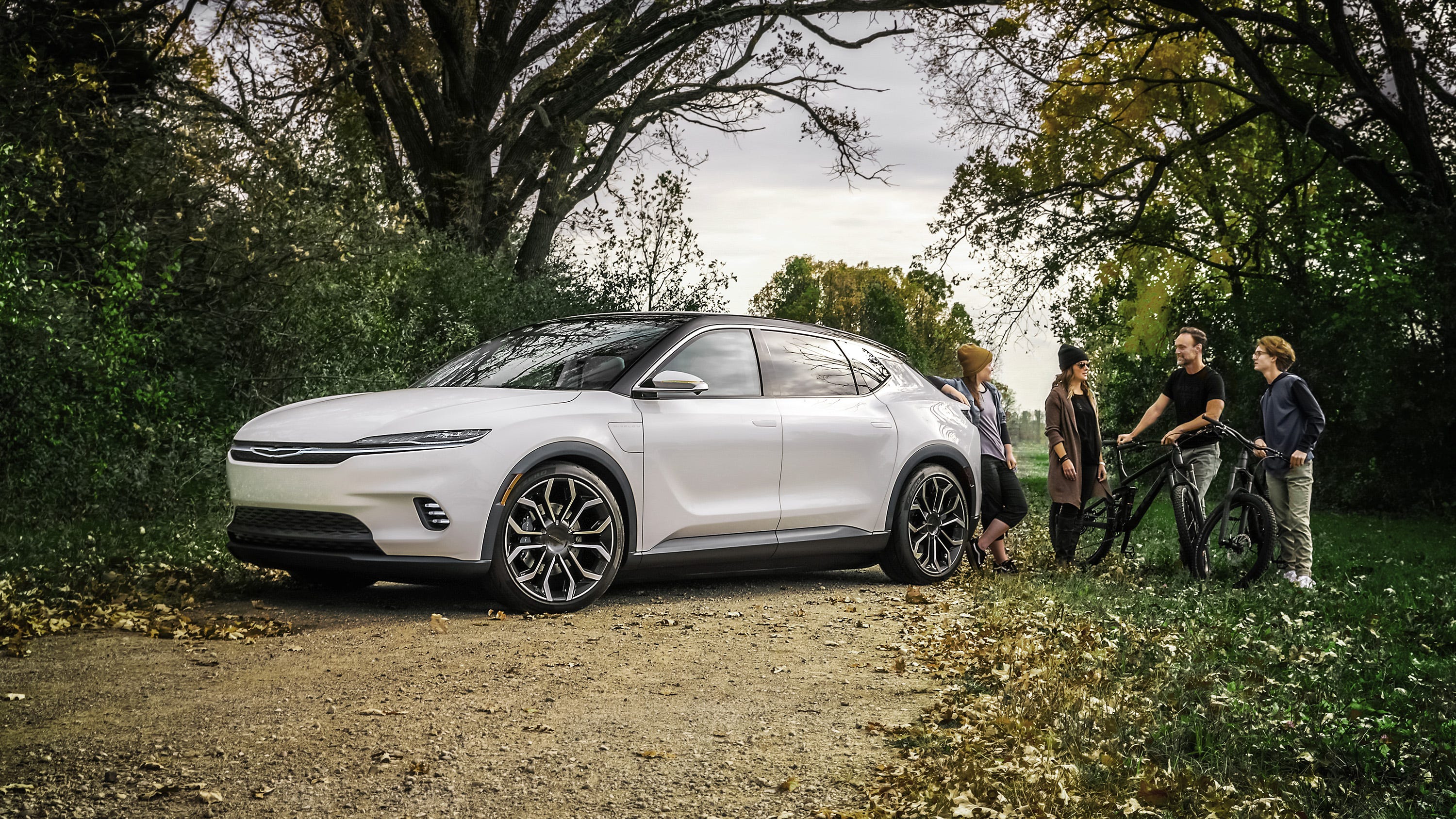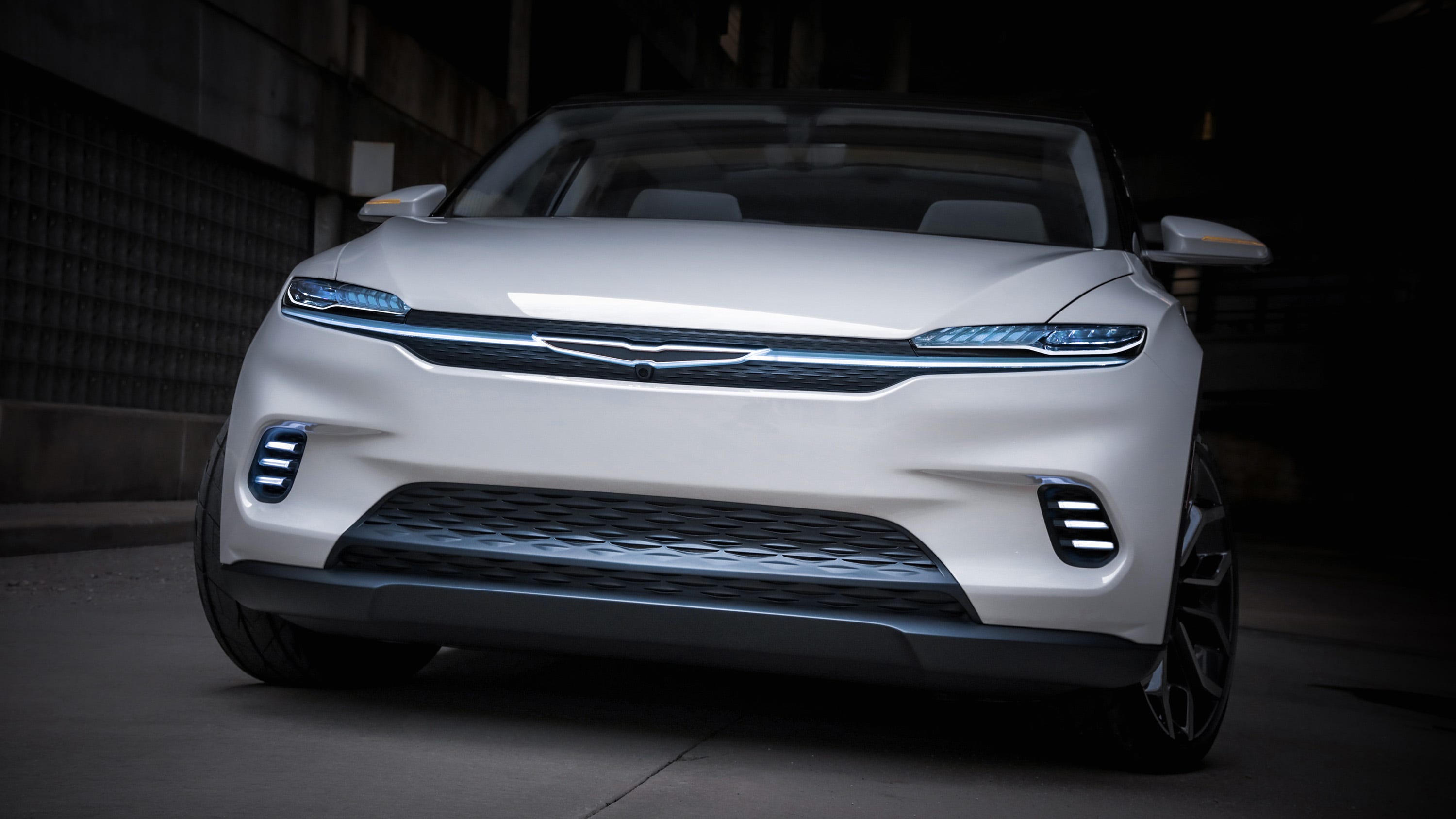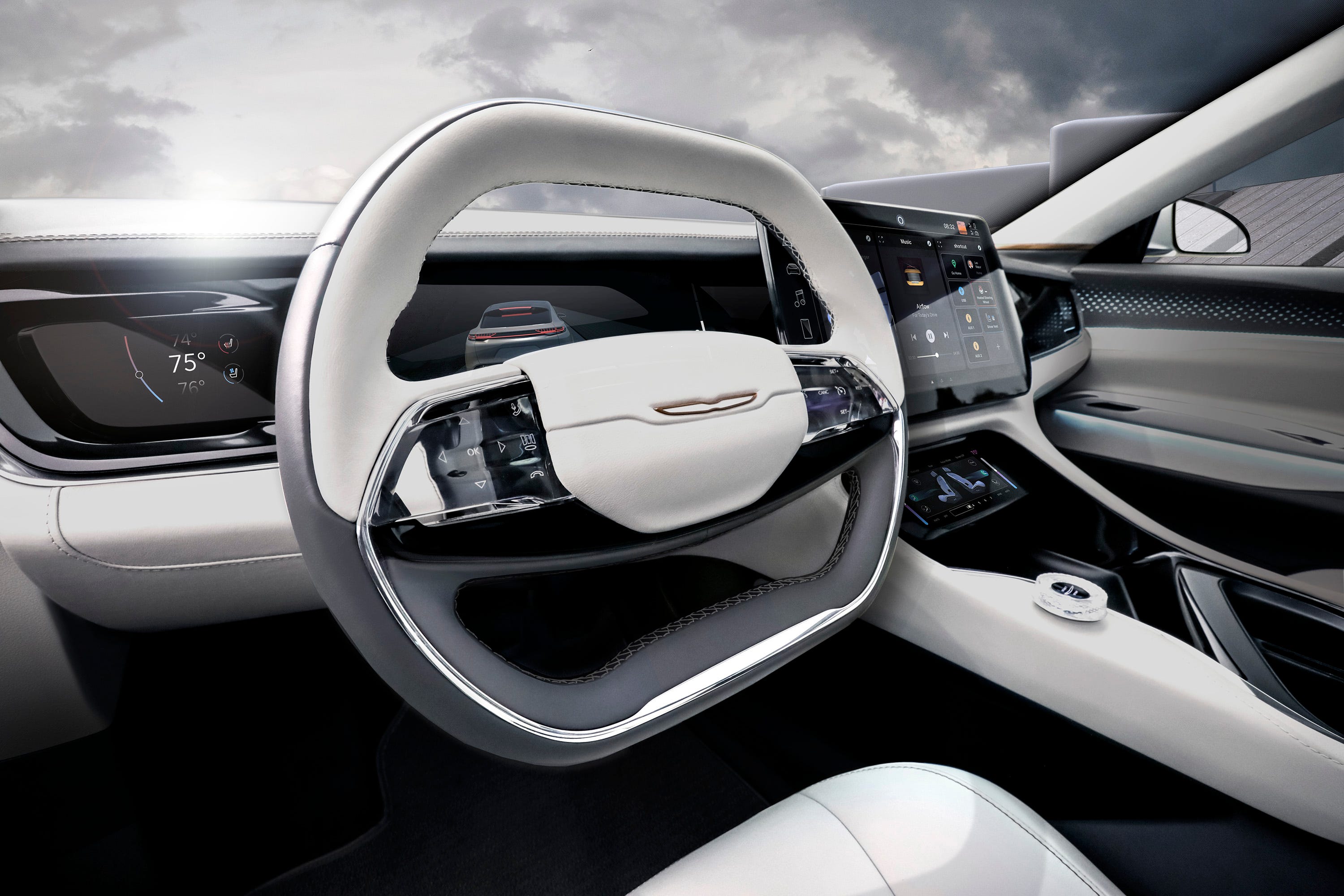Chrysler to go all-electric by 2028, target millennial women
 Breana Noble
Breana Noble
The Chrysler brand will abandon gas-powered vehicles for a bigger, all-electric lineup with SUVs by 2028 in its attempt to stave off demise at the end of the decade.
The Stellantis NV make on Wednesday will give a greater glimpse into that future during the CES trade show in Las Vegas. It's set to detail more about the sleek, electric Airflow five-passenger concept crossover offering a 350-to-400-mile range, according to the automaker — its first look at a new vision designed with millennial female customers in mind.
Buyers shouldn't expect a production model of the Airflow just yet, though. The new Chrysler CEO says a better representation of what the brand will bring to market will come in the next year or two. Chrysler's first EV will launch by 2025.
"We will be transforming the portfolio," CEO Chris Feuell told The Detroit News during a video chat, "to be very sustainability-focused and very technology-focused, but keeping in mind the need to support moving people and being accessible to our target audiences."

That frame is a bit different than Chrysler's current audience. The brand only offers the 300 full-size sedan and Pacifica minivan — vehicles in shrinking segments that have lacked significant investments over the past decade. The result is an "identity crisis" with words like "luxury," "people-mover" and "family" describing Chrysler, which experts have suggested could face the chopping block if nothing is done.
“When you don’t invest in product development and have a small showroom like they have had, and they shifted to the minivan, it’s hard to have a consumer know what the brand is when there is not enough products to express it,” said Stephanie Brinley, principal automotive analysts for the Americas at IHS Markit Ltd. “It needs love. It looks like it’s going to get the love it needs."
Up for the job is Feuell, a former marketing director at Ford Motor Co., who was hired by Stellantis in September from Honeywell Safety and Productivity Solutions, where she was the chief commercial officer.
Chrysler's current lineup "gives people the impression that we're a brand just for families," she said. "And I'm definitely looking to evolve that positioning beyond just the family positioning."

Stellantis CEO Carlos Tavares has given each of the automaker's 14 brands a decade to prove their worth. He said in Detroit last month that he asked the brand CEOs to choose a single word to describe their vision for each make. Chrysler's is "transformation," describing the change customers will see from styling to technology to service thanks to much-needed investment, the amount of which Feuell didn't specify. Stellantis overall is investing $35 billion into electrification and software by 2025.
"We think that the way particularly younger cohorts define family — it's not just the people or the family that they were born into," she said. "But it's the group of people that they have evolved to become close to, their tribe, their community, so to speak. And they do move in groups together, and we want to make sure that we're providing a vehicle that enables that mobility."

Other words emphasized by the new Chrysler are premium, athletic, urban and sustainable — a nod to the Pacifica being one of the few plug-in hybrids currently offered by the automaker in North America and an emphasis in the electric Airflow with floor mats, fabric and carpeting made from recycled materials and vegetable-tanned leather.
"If Chrysler can be positioned as a slightly upscale option for the family, it could be a very profitable niche to fill," said Sam Fiorani, vice president of global forecasting for AutoForecast Solutions LLC. "If there's a Ford, Toyota, Chevrolet in every driveway, and you as a buyer see Chrysler as a premium above those, that could make money for Stellantis, and keep the brand going for years to come."
Chrysler will have a new lineup with more vehicles, though the CEO declined to specify how many. There will be an offering in the largest segment, she said: "It's something that has been needed for a long time."
Stellantis last year launched the Wagoneer and Grand Wagoneer from the product designers of Jeep to compete with large SUVs like the Ford Expedition and even Cadillac Escalade. To separate itself from other offerings at the dealerships, Chrysler's focus will be on the on-road experience, not the off-road.
"We don't want to be a 'me too' in this segment," Feuell said. "So, we'll be differentiating, in part with the pure BEV technology that we'll be launching, the fast-charging capabilities with the 800-volt technology in a really sleek and dynamic exterior design, as well as carrying that theme through the interior as well."

Jeep, for its part, does plan to offer an all-electric version in each of its segments by 2025, including in the Wagoneer.
The Airflow concept does offer all-wheel-drive. Two 150 kilowatt electric drive motors, one in the front and one in the rear, power the vehicle. The design, the automaker says, is meant to accommodate larger drive motors to offer higher performance applications in the future.
The concept carries a sporty attitude with slim LED lights that glow blue when the vehicle is charging. It has a two-tone roof line, panoramic ceiling and 22-inch tires. Inside, it's all about the technology, with the Airflow showcasing the software highlighted by Stellantis during its virtual Software Day last month when it first showed the Airflow.
“The design," Ralph Gilles, Stellantis' chief design officer, said in a statement, "features a decisively elegant aerodynamic exterior and a modern, sophisticated interior that takes the customer on a new level of digital delight."

Based on the STLA Brain electrical architecture, the STLA SmartCockpit developed by Mobile Drive, Stellantis' joint venture with iPhone manufacturing contractor Foxconn Technology Group, provides artificial intelligence-based navigation, voice assistance, e-commerce marketplace and payment services. Passengers can customize their experience on screens, change ambient lighting, and with cameras embedded in each seat, hold a conference call with everyone in the car.

The vehicle also is equipped with STLA AutoDrive offering Level 3 automated driving capability, which means a human doesn't need to supervise the vehicle, but must be alert in case of the system failing. The system has been developed with BMW.
Chrysler is in need of an SUV, though crossover nameplates have proliferated over the past couple of decades, AutoForecast's Fiorani said.
"Re-establishing Chrysler as a brand in a crowded market will be tough; however, an electrified model could be the step up that Chrysler needs to make a splash," he said. If a production model launches in the fall of 2024, "it’s probably in the meat of when this market would fill up. It'd be better to get to market sooner. Too much of a delay on this product would hamper its chances in the marketplace."

Designing a new crossover on a new EV-designed platform takes time, though. Although Stellantis already offers electric crossovers in Europe, they are mostly compact vehicles that aren't popular with American buyers and have platforms designed for internal combustion engine vehicles that are converted to electric.
"There's shortcomings with that," Fiorani said, "like not being able to place the batteries as low as possible, which can compromise handling and interior space."
For now, annual launches are planned between 2025 and 2028, Feuell said: "Obviously, if I can get them sooner, I will."

Chrysler also will look to "redefine" the current segments in which it plays, she said. The brand sees a market for electrified large sedans and will have an offering to replace the 300. Chrysler also will look to uphold its heritage in pioneering the minivan almost 40 years ago — that innovation is inspiration for Chrysler's next chapter.
Its new customer focus is a college-educated millennial woman who is active in her urban or suburban community and cares about the environment. Her income at $100,000 a year is higher than today's typical Chrysler buyer, Feuell said.
"Even though that persona is not representative of the average consumer that purchases a Chrysler today, when we launched the Pacific PHEV product, we found a much younger audience aligning to our target persona: millennial female, higher income and also higher multicultural mix," she said. "So we're really excited to see that trend. It shows that we can, as a Chrysler brand, attract those kinds of consumers."
She identified the sweet spot in pricing for a mainstream EV brand to be $45,000 to $60,000, which she said is roughly the average transaction prices Chrysler's vehicles are seeing amid low inventory levels because of a microchip shortage that has frequently halted production at its plants in Ontario.
Feuell wouldn't specify where future product would be assembled as decisions still are being made. AutoForecast Solutions predicts a production version of the Chrysler Airflow could be built alongside future electric Dodge muscle cars in Belvidere, Illinois, since both will use the Auburn Hills-engineered STLA Large EV platform.
Belvidere currently builds the Jeep Cherokee crossover, which AutoForecast says could move to Toluca, Mexico, with the Jeep Compass. That plan could leave Brampton Assembly Plant in Ontario without any product. It currently builds the Dodge Charger and Challenger as well as the 300.
"We haven't finalized the production strategy or the industrialization strategy yet," Feuell said. "For now, Chrysler's really focused on re-establishing and rebuilding in North America, and so, I think you can expect production to be within the region."
bnoble@detroitnews.com
Twitter: @BreanaCNoble